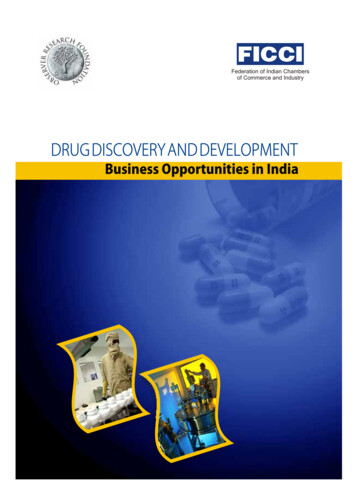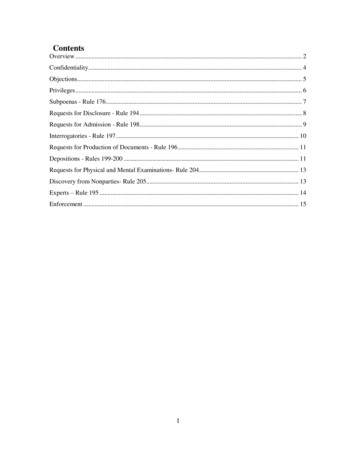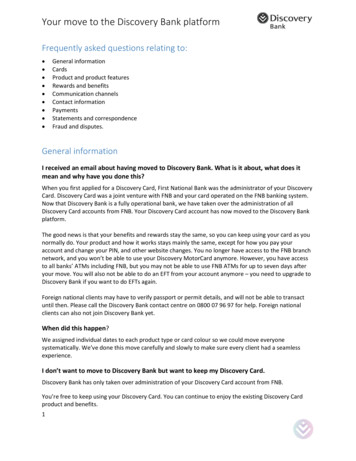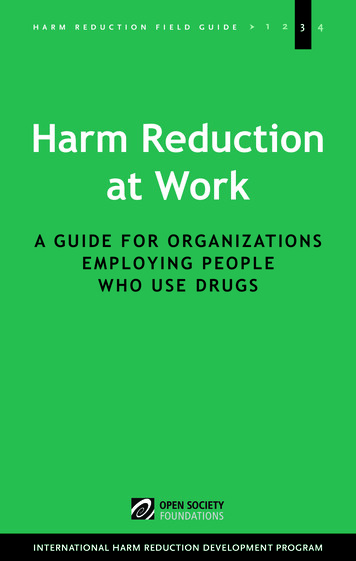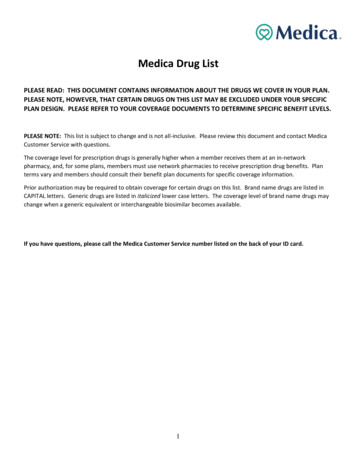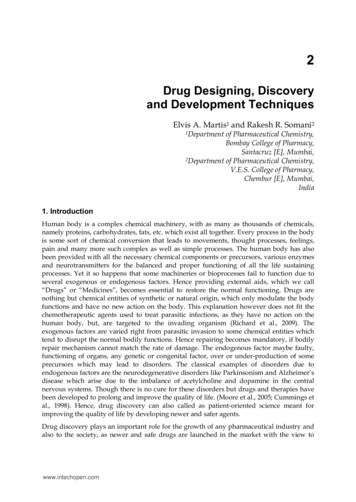
Transcription
2Drug Designing, Discoveryand Development TechniquesElvis A. Martis1 and Rakesh R. Somani21Departmentof Pharmaceutical Chemistry,Bombay College of Pharmacy,Santacruz [E], Mumbai,2Department of Pharmaceutical Chemistry,V.E.S. College of Pharmacy,Chembur [E], Mumbai,India1. IntroductionHuman body is a complex chemical machinery, with as many as thousands of chemicals,namely proteins, carbohydrates, fats, etc. which exist all together. Every process in the bodyis some sort of chemical conversion that leads to movements, thought processes, feelings,pain and many more such complex as well as simple processes. The human body has alsobeen provided with all the necessary chemical components or precursors, various enzymesand neurotransmitters for the balanced and proper functioning of all the life sustainingprocesses. Yet it so happens that some machineries or bioprocesses fail to function due toseveral exogenous or endogenous factors. Hence providing external aids, which we call“Drugs” or “Medicines”, becomes essential to restore the normal functioning. Drugs arenothing but chemical entities of synthetic or natural origin, which only modulate the bodyfunctions and have no new action on the body. This explanation however does not fit thechemotherapeutic agents used to treat parasitic infections, as they have no action on thehuman body, but, are targeted to the invading organism (Richard et al., 2009). Theexogenous factors are varied right from parasitic invasion to some chemical entities whichtend to disrupt the normal bodily functions. Hence repairing becomes mandatory, if bodilyrepair mechanism cannot match the rate of damage. The endogenous factor maybe faulty,functioning of organs, any genetic or congenital factor, over or under-production of someprecursors which may lead to disorders. The classical examples of disorders due toendogenous factors are the neurodegenerative disorders like Parkinsonism and Alzheimer’sdisease which arise due to the imbalance of acetylcholine and dopamine in the centralnervous systems. Though there is no cure for these disorders but drugs and therapies havebeen developed to prolong and improve the quality of life. (Moore et al., 2005; Cummings etal., 1998). Hence, drug discovery can also called as patient-oriented science meant forimproving the quality of life by developing newer and safer agents.Drug discovery plays an important role for the growth of any pharmaceutical industry andalso to the society, as newer and safe drugs are launched in the market with the view towww.intechopen.com
20Promising Pharmaceuticalsimprove the therapeutic value and safety of the agents. The pharmaceutical industry hasconsistently shown that it can discover and develop innovative medicines for a wide rangeof diseases (Ratti & Trist, 2011). The revenue that flows in with the invention of neweragents has always been the motivation for the industry to keep up the pace and keep abreastwith the ever increasing demand for medicines.The advent of molecular biology, along with numerous developments in the screening andsynthetic chemistry technologies, has allowed learning both, the knowledge about thereceptor and random screening to be used for drug discovery. Today, more or less allpharmaceutical industries follow common techniques for discovering drugs. These includecloning and expressing human receptors and enzymes in formats that allow highthroughput screening and the application of combinatorial chemistry. Thus, randomscreening can now be done with libraries sufficiently large and diverse to have a relativelyhigh probability to find a novel molecule. These libraries are possible because they can begenerated by the techniques of combinatorial chemistry (Black, 2000).Drug research, as we know it today, began its career when chemistry had reached a degree ofmaturity that allowed its principles and methods to be applied to the problems outside ofchemistry itself and when pharmacology had become a well-defined scientific discipline in itsown right. By 1870, some of the essential foundations of chemical theory had been laid.Avogadro's atomic hypothesis had been confirmed and a periodic table of elementsestablished. Chemistry had developed a theory that allowed it to organize the elementsaccording to their atomic weights and valencies. There were set of theories of acids and bases.In 1865, August Kekulé formulated his pioneering theory on the structure of aromatic organicmolecules (Drews, 2000a and 1999b). During the first half of the 20th century drug researchbegan shaping up and was developed by several new technologies, which carried the drugdiscovery process to its best. Biochemistry also had tremendous influence on drug research inmany ways. The concept of targeting enzymes as drug targets came in to existence, that led tothe designing of enzyme substrates which acted either as inhibitors or showed their action bymodifying various feedback mechanisms. (Meidrum & Roughton, 1933).Table 1 shows some important discoveries in the field of medicine, right from 19th century to21st centurySr. no1.2.3.4.5.6.7.8.9.10.Year of 1.2001Drug deL-dopaArtemisininSildenafilCelecoxib, RofecoxibZanamavir,OseltamivirImatinibTable 1. Important discoveries in medicinewww.intechopen.comCategoryHypnotic agentAnalgesic and Anti-pyretic agentAnti-Diabetic agentAntibioticTranquillizerAnti-Parkinson agentAnti-malarial agentErectile Dysfunctioning treatmentSelective COX-2 inhibitorsAnti-influenza agentsLeukemia treatment
Drug Designing, Discovery and Development Techniques21The present day drug discovery process is a very time consuming process as it takes at least14-16 years of research for a molecule to completely transform into a drug. There are several100 basic research projects, before desired molecule is discovered. But, this molecule is not yetready to be called as a drug. After the pre-clinical establishment and confirmation of its actionand toxicity data, the FDA approves the candidate for clinical studies. The Clinical phase of thestudy takes at least 6-8 years, before the candidate can be launched in to the market. Afterthis stage, the molecule is said to have transformed from a molecule to drug. Even after thelaunch of the drug in the market, the post-marketing surveillance and pharmacovigilanceprogram is being carried out to find out whether any new adverse reaction orincompatibilities towards other agents, when given as combination therapies. (Congreve, et al.,2005). Figure 1 depicts the entire drug discovery process with the tentative timeline.Fig. 1. Drug discovery and development process (Lombardino and Lowe, 2004).2. Drug discovery processDrug discovery process basically is a patient oriented science, where researchers strive toimprove the existing drugs or invent a totally new chemical entity, which should be ideallymore potent than any existing drug of a similar category. If not, then at least it should besafer than those existing. This process is a very time consuming and expensive activity,calling for the expertise of many eminent researchers. It takes nearly 12-14 years ofexhaustive research and a huge amount of financial investment for the discovery of a singledrug. Right from the chemical synthesis to its clinical development and finally formulatingit to a suitable form. Failure at any stage would mean a huge loss for the company. Hence, alot of planning is required even before the project is underway. Recently, with the use oftechnology the process is becoming a less risky business, because of the ability of thecomputers to predict the possible outcomes. This will surely reduce the efforts in fruitlessdirections (Augen, 2002).www.intechopen.com
22Promising PharmaceuticalsThe following paragraphs shall discuss the various stages of drug discovery process.2.1 Identification of biological targetsThe human body functions normally by the virtue of the biochemical process which go on,producing all the necessary chemicals required for numerous functions to undergosmoothly within the body. Many of these processes are regulated by the enzymes and theendogenous effector molecules via their respective receptors. A diseased state, may hence,be identified by, either the abnormal biochemical functioning or, over or underproduction ofsome of the intermediates. Hence , the most important and most common biological targetsfor drug discovery are either enzymes regulating the biochemistry or the receptors throughwhich many hormones and endogenous effectors show their response. For example,inhibition of human dihydrofolate reductase, by methotrexate, brought under control thegrowth of tumour in humans (Borsa and Whitemore, 1969). Similarly, blocking of the betaadrenoceptors in the cardiac muscles was found to reduce the hypertensive state (Pearson,et al., 1989). Another type of biological targets are nucleic acids. Though they are rarelytargeted as compared to those mentioned above, yet they are important targets.(Overington, et al., 2006).2.2 Validation of biological targetsOnce the target is identified, it becomes absolutely necessary to confirm, that the correcttarget has been identified. The use of reliable and suitable animal models and the latesttechniques in gene targeting and expression are all essential to the validation process.(Abuin, et al., 2002). Validation also helps researchers to identify any secondary target thatthe drug may bind to, which may lead to any sort of unwanted or adverse reaction. Ideallythe drug candidate should be such that it binds to a single target only, but this seldomhappens. Thus, binding to other targets, apart from the correct target leads to unwantedpharmacological actions. These cannot be completely avoided. It can be minimized tonegligible extent. (Marton, et al., 1998). G-protein coupled receptors (GCPRs) are the mostcommon and the major targets where a drug binds. Hence, over 30% of drugs in market aremodulators of GPCR. The quantitative polymerase chain reaction (qPCR) analysis is one ofthe techniques used to measure the mRNA expression on the receptor. (Wise, et al., 2002).2.3 Lead structure searchA lead compound is the one that has basic structural requirements for exhibiting the desiredaction. This means that, a lead compound has many structural spaces for furtherdevelopment of the structure, to give a compound with further enhanced action. Highthroughput screening is a technique, which helps to identify the lead compound out of themany synthesized compounds or those compounds which are collected from the naturalsource. Hence, it becomes utmost important to identify the lead compound, as this forms thebasis for further development of the molecule(s). (Bleicher, et al., 2003). Figure 2 illustratesthe design cycle for lead search. The various other techniques involved in lead identificationare virtual screening, informatics, pharmacaphore mapping, High throughput docking,NMR-based screening and chemical genetics. (Xue and Bajorath, 2000).www.intechopen.com
Drug Designing, Discovery and Development Techniques23Fig. 2. The Design cycle describes the optimization of a lead structure to one or severaldevelopment candidates.2.4 Lead optimizationAs soon as the lead structure is identified, the next step is to optimize the same. Here, thechemists in close collaboration with the pharmacologists will carefully study the structureactivity relationship and will synthesize such other derivatives, so as to get a compoundwith the best possible desired activity. The various other approaches for lead optimizationare Structure-Based Drug Design (SBDD), Quantitative Structure-Activity Relationship(QSAR) and Computer-Assisted Drug Design (CADD). All such approaches generate a hugeamount of data, so as to assist the chemist in optimizing the lead to the best possiblestructure, with best possible desired action. These aforementioned approaches shall be dealtin detail in the later part of the chapter. (Joseph-McCarthy, 1999 & Ooms, 2000). Figure 3represents the design cycle for lead optimization and drug development.Fig. 3. Design cycle for lead optimizationwww.intechopen.com
24Promising Pharmaceuticals2.5 Preclinical studiesThe main objective of preclinical studies is to ascertain the safety of the newly developedmolecule. A newly developed molecule is never permitted to be tested on the human body,unless supported by a confirmed data about the pharmacology and toxicology of themolecule which is, based on animal studies is obtained. This phase, generally deals withelucidating the mode of action the molecule and getting an idea about the pharmacokinetics(PK) and pharmacodynamics (PD) of the molecule. However, the most important is thetoxicological data obtained from the animal study, which gives the rough estimate about thepossible adverse reactions that may be likely to be seen during the course of the therapy.These are carried out in two stages, in-vitro studies and in-vivo studies. The in-vitro studiesmake use of different cell-lines and tissue preparations. The in-vivo studies are performedon the live animals and are observed the changes in the animal’s behavior. (Caldwell, et al.,2001 & Smith, and van de Waterbeemd, 1999).2.6 Clinical trialsThe next stage after preclinical studies is the clinical studies, actual testing of the moleculein the human volunteers. This phase allows to assess the safety and efficacy of the newmolecule. This phase also allows to gather information about the toxicological effects in thehuman body, as seldom the toxicity shown by animals, cannot be always directlycorrelated to the humans. Before the start of this stage, the innovator should file anapplication, namely, “Investigational New Drug (IND)”, as the FDA approves based onthe preclinical data, the innovator can proceed for clinical studies. This stage consists ofthree phases, phase 1, phase 2, phase 3 and the phase 4 studies are carried out after thedrug has been launched in to the market.Phase 1 studies are usually carried out on healthy human volunteers and on a small group ofpeople. This phase evaluates the safety, tolerability and PK and PD of the new molecule.Phase 2 studies are generally carried out on a small population with the target disease. Inthis phase, the drug’s efficacy and safety, metabolism and PK are evaluated in a diseasedhuman body.Phase 3 studies are extensive and multiple site studies. This phase, covers a large group ofindividuals with target disease. This phase basically is a therapeutic confirmatory phase, asall the parameters studied in the phase 2 of the study are confirmed in this phase. This phasemay take somewhere about 3-6 years to complete. After this phase is successfullycompleted, the company files the “NEW DRUG APPLICATION (NDA)”to the FDA. Oncethe FDA issues an approval to the company, based on their data compiled from the clinicaltrials, the drug can be launched in the market.Phase 4 (Post-Marketing survilience) studies are carried out, after the drug has beenlaunched into the market. The company continues its monitoring of the drug. Therationale behind this phase is to check for any new adverse or serious reaction which wasnot detected in the earlier phases and may be observed in this phase. If so happens thatsome serious adverse reaction is observed, the company may withdraw the drug from themarket. (Singh, et al., 2011).www.intechopen.com
Drug Designing, Discovery and Development Techniques252.7 Formulations for clinical studiesThe formulations for clinical studies are usually prepared as capsule dosage form, as it iseasy for formulation and also easy for administration. Apart from this advantage, there isanother key factor to be considered while formulating a trial batch, as the drug itself has notbeen tested in humans, any untoward action can be directly ascertained to the drug in theabsence of any excipients. Capsules, unlike the tablets can be formulated without any orminimal excipients. Liquid dosage forms may also be formulated, provided the drug iswater-soluble, for the ease of preparation and water being the safest medium. Formulationsshould be properly tested for its stability and must be stable at least for the period the trialsare underway. The other reason for choosing simple formulations is to avoid any time lag,as the process of trials itself is lengthy. Any more delay, may further lead to the delay inmarketing the drug.3. Computer-aided drug designComputers, have found their way in every field of science and technology today. The boonof computers is that a large number of calculations and observations can be done in no time.Drug discovery and designing is no exception to this generalization. Drug designing hasreceived a many fold face-lift by the virtue of computer software dedicated to the designingof ligands and identifying the biological targets. Computer generated structures serve to begood predictive models for the evaluation of biological activity.A drug exhibits its action when it binds to its biological target, usually receptors. Receptorsare nothing but proteins with active sites for the binding of ligands. Hence, in order todesign a good ligand, it becomes necessary to know the structure of such receptors and toidentify their active sites accurately. The two important aspects involved in predictingmolecular-interactions in computer-aided drug design (CADD) are development ofpharmacophore-based and molecular docking and scoring techniques. Computerizedstructure of the known proteins is based on the experimental data present in variousliteratures and protein data banks. With this, it is possible to deduce the 3D structure of theall the known proteins with the help of sequence homology approach. Hence, thesehypothetical proteins behave more or less like the real proteins in their native biologicalenvironment (Taft, et al., 2008). Recently, many computer-assisted models are beingdeveloped and several thousand candidates are being screened for various activities usingthese models. The methods of choice for this purpose are computer programs thatsuperimpose molecules by a flexible alignment to derive pharmacophoric patterns and/orquantitative structure-activity relationships, dock molecules to the surface of a protein 3Dstructure or to a hypothetical pseudoreceptor, or construct new ligands within a predefinedbinding site (Klebe, 1995 & Kubinyi, 1998a).Different molecular property fields, such as electrostatic, steric, hydrophobic, hydrogenbond acceptor and donor fields, as well as their weighed combinations, have been used toachieve a fully automated alignment of the molecules. (Mestres, et al., 1997). The process ofdocking process involves the prediction of ligand conformation and orientation within atargeted binding site. Docking is basically performed for accurate structural modelling andcorrect prediction of the biological activity. Figure 5 depicts an image witch is generated bydocking studies (representational purpose only)www.intechopen.com
26Promising PharmaceuticalsFig. 5. Representation of molecular docking (Bo, et al., 2010).Type of studyProtein-Ligand dockingProtein-Ligand & ProteinProtein kInnovatorThe Scripps Research InstituteSandia National LabsUniversity of AlbertaOpenEyeTriposBioSolveIT GmbHSchrödinger GmbHCDCCVirginia CommonwealthUniversityUCSF Molecular DesignInstituteUniversity of KansasMolSoft LLCTable 2. lists the various computer programmes used for docking studies. (Structure baseddrug design and molecular modelling, http://www.imbjena.de/ rake/Bioinformatics WEB/dd tools.html)4. Molecular modelling and drug designTheoretical studies of biological molecules permit the study of the relationships betweenstructure, function and dynamics at the atomic level. The entire process is about simulationof the biological processes and quantum mechanical calculation based on the principles ofchemistry and physics.4.1 Molecular mechanics- force field (Potential energy function)Current generation force fields (or potential energy functions) provide a reasonably goodcompromise between accuracy and computational efficiency. They are often calibrated toexperimental results and quantum mechanical calculations of small model compounds.Their ability to reproduce physical properties measurable by experiment is tested; thesewww.intechopen.com
Drug Designing, Discovery and Development Techniques27properties include structural data obtained from x-ray crystallography and NMR, dynamicdata obtained from spectroscopy and inelastic neutron scattering and thermodynamicdata. (MacKerell, et al., 1995).The molecular structures, properties and energies of a molecule are better understoodthrough the use of the mechanical molecular model. This model involves the developmentof a simple molecular mechanics energy equation representing the sum of various energyinteraction terms comprised of bonds, angles, torsions of both bonded and non-bondedatoms. Force fields the model serves as a simple descriptor for vibrations in molecules. Theconcept of force fields is now widely employed as one of the simplest tools in molecularmodeling.Force fields are fundamentally important in de novo drug design programs, inpharmacophore mapping, and represent the “scoring functions” in many dockingprograms. As scoring functions, force fields are used to rank “ligand poses” obtained by adocking algorithm, or in de novo ligand design programs to suggest placement offragments in the sites in the enzyme with the highest binding affinity. In all theseapplications, force fields are mainly used to compute the interaction energy between theprotein and the ligand as pair-wise interaction potentials consisting of van der Waals andelectrostatic interactions, in addition to H-bond energy between the ligand and theenzyme. (Pissurlenkar, et al., 2009).4.2 Energy minimization methodsThe goal of energy minimization is to find a route from an initial conformation to thenearest minimum energy conformation using the smallest number of calculations possible.NMR and X-ray crystal structures tend to have high energy interactions like Paulirepulsions. That is because the methods to retrieve molecular structures are not perfect andespecially in x-ray-structures there are crystal contacts, which lead to a compaction of themolecules. Moreover, hydrogen atoms are added to relatively arbitrary positions near theirneighbors. Thus, there are atoms lying too close together so that the Pauli repulsionoutweighs the dispersion attraction and the energy is raised high above natural energylevels. These high energy interactions lead to local distortions which result in an unstablesimulation. They can be released by minimizing the energy of the structure before starting arun. The minimization results in a structure with energy near the lowest possible energy thesystem can have. (Leach, 2001 & Höltje, et al., 2003)4.3 Conformational analysisConformational analysis deals with the computation of minimal energy configurations ofdeformable molecules and docking involves matching one molecular structure to thereceptor site of another molecule and computing the most energetically favorable 3-Dconformation. (Go and Scherga, 1970).4.3.1 Systematic search (Scheraga, et al., 1992)Due to the convoluted nature of the potential energy surface of molecules, minimizationusually leads to the nearest local minimum, and not the global minimum. To scan thewww.intechopen.com
28Promising Pharmaceuticalspotential surface with some surety of completeness, systematic, or grid, search procedureshave been developed. The following protocol is used for the same,1.2.3.4.5.6.7.Rigid geometry approximationCombinatorial nature of the problemPruning the combinatorial treeRigid body rotationsExploitation of ringsConformational clustering and familiesConformational analysis4.3.2 Monte Carlo simulationThe Monte Carlo simulation is based on statistical mechanics and generates sufficientdifferent configurations of a system by computer simulation to allow the desired structural,statistical, and thermodynamic properties to be calculated as a weighted average of theseproperties over these configurations. A useful application has combined Monte Carlosampling with variable temperatures (simulated annealing) to optimize the docking ofligands into active sites. (Allen, & Tildesley, 1989)4.3.4 Molecular dynamic simulationMolecular dynamics is a deterministic process based on the simulation of molecular motionby solving Newton’s equations of motion for each atom and incrementing the position andvelocity of each atom by use of a small time increment. Molecular dynamics simulationsrepresent another technique to sample configuration space, based on the aforementionedprinciple. Combined with the use of “reasonable” temperatures (a few hundreds orthousands of degrees), this means that only the local area around the starting point issampled, and that only relatively small barriers (a few tens of a kJ/mol) can be overcome.Different (local) minima may be generated by selecting configurations at suitable intervalsduring the simulation and subsequently minimizing these structures. MD methods use theinherent dynamics of the system to search out the low-energy deformation modes and theycan be used for sampling the conformational space for large confined systems (Tuckerman,& Martyna, 2000).4.4 Structure-based and Ligand-based drug design approachesStructure-based drug design by the use of structural biology remains one of the most logicalapproaches in drug discovery. It combines information from several fields: X- raycrystallography and/or NMR, molecular modeling, synthetic organic chemistry, QSAR, andbiological evaluation (Marrone, et al., 1997). Figure 6 shows the schematic process.Many of the naturally occurring molecules are found to be very potent, and also theendogenous chemicals give a lot of information for drug designing. The use of such ligandsto generate and design newer ligands is called ligand-based drug design. Many a timesstraightforward design process starts from conformationally restricted natural receptorligands, such as from polypeptides or proteins. Some of the applications of structure andligand based drug design are Renin and protease inhibitors, β-lactamase inhibitors, reversewww.intechopen.com
Drug Designing, Discovery and Development Techniques29transcriptase inhibitors, angiotensin converting enzyme inhibitors, HIV-1 integraseinhibitors and many more. (Kubinyi, 1998b).Fig. 6. Representation of structure based drug design.4.5 3D pharmacophore modelingVarious conformations of a range of ligands that all act at the same receptor site can providesignificantly more information than just a single ligand structure. With a sufficiently broadrange of ligands, it is often possible to generate a pharmacophore model of the receptorsite. The advantage of such a pharmacophore model is that smaller, non-peptide moleculesthat might have improved stability and bioavailability over their peptide counterparts canbe designed, relative easy and certain amount of confidence towards getting successfuloutcome. (Nielsen, et al., 1999).4.6 Rational drug designThe Concept of rational drug design simply lies in logical reasoning before designing anytherapeutic agents. For example, to prepare any competitive inhibitor of a particular target,the logic of predicting the structure is to simply design an molecule with similar structuralfeatures exhibited by the endogenous agent or by closely examining the active binding site.Close examination of the active site gives many hints about the interacting amino acidresidues, so it becomes simple to predict the nature and type of substituents and thefavorable position in the molecule, which will favor better binding.4.6.1 Design of enzyme inhibitorsAlmost every biochemical process in the human or parasite is catalyzed by various enzymesof diverse function. As a result enzymes have always been the hot target for designing newdrugs for various clinical conditions. The most popular example is the inhibition ofacetylcholinesterase enzyme in the human brain is one of the most successful targets to treatthe symptoms of Alzheimer’s disease. The first step in designing an agent to inhibit anenzyme is to study thoroughly the structure and the binding site/pocket of the endogenouswww.intechopen.com
30Promising Pharmaceuticalssubstrate. It is always favorable to design the new agent based on the structuralrequirements into the pocket of the catalytic site of the enzyme based on endogenoussubstrate or agents already designed for the purpose. The binding of the inhibitor should bemore preferred or favourable than the endogenous substrate, in order to develop asuccessful inhibitor and at the same time care should also be taken so as to not develop anirreversible inhibitor, this may permanently destroy the enzyme. Popular drugs designed inthis fashion are the HIV-1 protease inhibitors, thrombin inhibitors, neuraminidase inhibitorsand many more. (Prasad, et al., 1996, Kimball, 1995 & Wade, 1997).4.6.2 De Novo Ligand designDesigning of novel chemical structures that are capable of interacting with a receptor ofknown structure using methodology that is much more reliable, is what we call De NovoLigand design. Techniques for the design of novel structures to interact with a knownreceptor site are becoming more and more available and have shown a lot of promise forthe future. The thorough understanding of the various classes of chemicals interacting withthe particular receptor, can give a lot of information to design novel agents by replacing thescaffold with another one to have similar sort of interaction and at the same binding site.(Klebe, 2000 & Bohm, and Stahl, 2000).5. Quantitative Structure Activity Relationship (QSAR)QSAR correlate
Drug Designing, Discovery and Development Techniques 21 The present day drug discovery process is a very time consuming process as it takes at least 14-16 years of research for a molecule to comp letely transform into a drug. There are several 100 basic research projects, before desired molecule is discovered. But, this molecule is n ot yet

